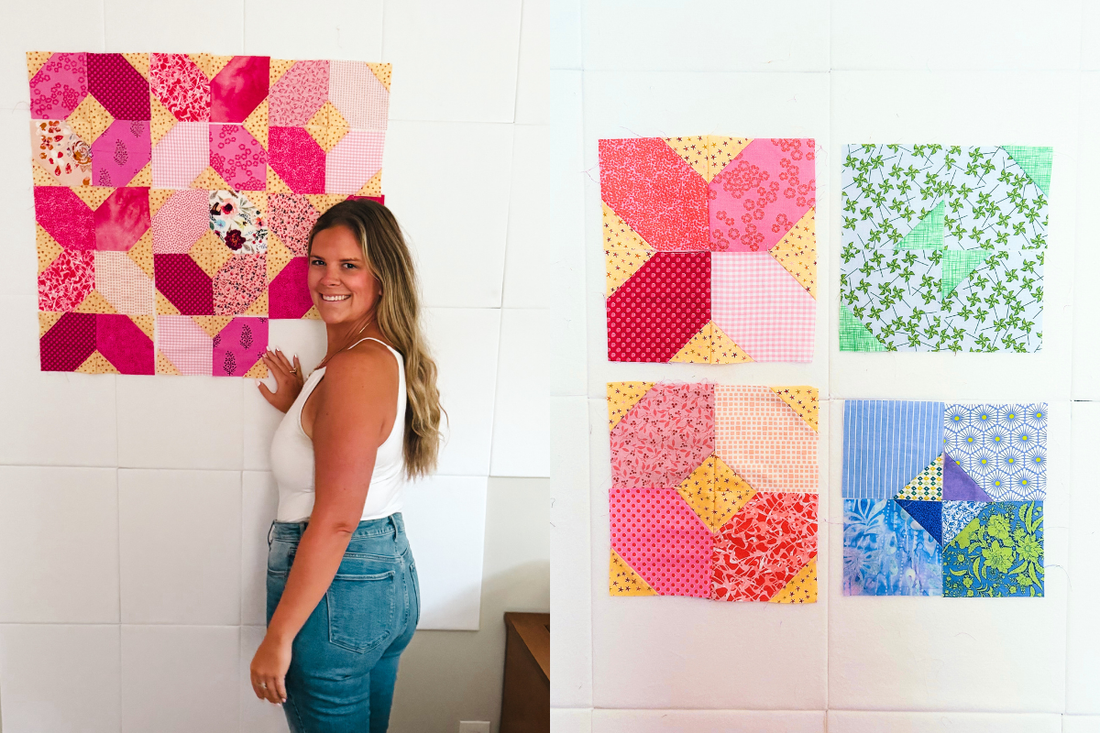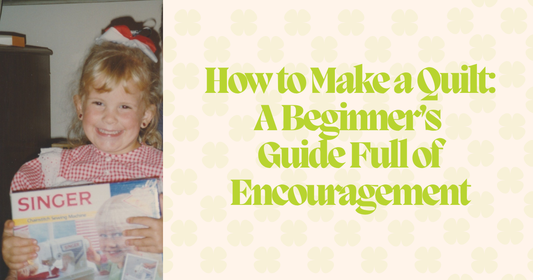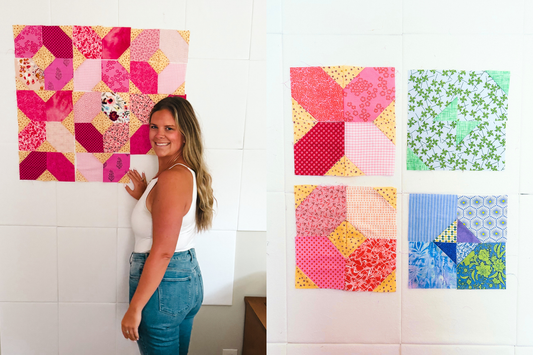
How to Make a “Snowball” Block (My Favorite Chain-Piecing Shortcut)
Share
Quilting is one of those rare hobbies that manages to be equal parts practical, creative, and relaxing. Few things are more satisfying than turning a pile of fabric scraps into something beautiful and lasting. And while there are countless quilt blocks to explore, I want to share one of my go-to building blocks that combines ease with impact: what I like to call the Snowball Block.
Technically speaking, most quilting books and patterns don’t call it a snowball block. But I first picked up the nickname from tutorials that use the snowball method—and over time, it’s the term that stuck for me. The block is simple to put together, endlessly versatile, and perfect for scrap busting. The best part? It looks much more advanced than it really is.
This post is a deep dive: I’ll explain why this block works so well, how chain piecing can speed up your sewing, the tools and fabrics you’ll need, and some fun layout inspiration. Then we’ll head into the step-by-step photo tutorial so you can make your own.
Why I Love This Block
One of the joys of quilting is that a block doesn’t need to be complicated to look impressive. This “Snowball” Block is a perfect example:
- It looks polished and complex – but it’s just a clever arrangement of squares and triangles.
- It’s scrap friendly – you don’t need a huge yardage cut. Small pieces, leftovers, or precuts (like charm squares or layer cake squares) all work beautifully.
- It plays well with others – you can mix it into a sampler quilt, alternate it with nine-patches, or make an entire quilt top out of this block alone.
- It’s approachable for beginners but still fun for experienced quilters who want to batch sew something quick and rhythmic.
I’ve lost track of how many times I’ve come back to this block when I need something quick, colorful, and satisfying. It never disappoints.
What Is Chain Piecing?
Before we get into cutting and sewing, let’s pause on chain piecing, because it’s the technique that makes this block so fast and consistent.
Chain piecing is when you continuously sew multiple fabric units without cutting the thread between them. You just keep feeding one unit after another under the presser foot. Once you finish a “chain,” you snip the threads between pieces.
Here’s why it’s worth trying:
- Saves time: Instead of stopping and starting for each unit, you sew them in one go.
- Saves thread: You waste far less on trimming or leader scraps.
- Keeps rhythm: Sewing the same step repeatedly builds muscle memory, and your seams come out more even.
- Feels efficient: There’s something deeply satisfying about seeing a long chain of units trail off your machine.
If you’ve never chain pieced before, this tutorial is the perfect introduction. It’s easy, quick, and once you get into the flow, you’ll wonder why you didn’t try it sooner.
A Quick Accuracy Hack: Washi Tape
Accuracy matters in quilting, and one of the easiest tricks I know is to use washi tape on your sewing machine.
Here’s what to do:
- Line up a strip of washi tape (or painter’s tape) on your throat plate at needle line, for this block.
- Most patterns call for a ¼″ seam, but if you’re working with a design that uses something different, place your tape accordingly, for any project.
Materials You’ll Need
The best part about this block is that you don’t need anything special, just your standard quilting setup and some scraps.
- Fabric:
- Scraps, fat quarters, or precuts (charm packs or layer cakes work well)
- A background fabric to help your colors pop
- Tools:
- Rotary cutter and cutting mat
- Quilting Ruler (helpful for trimming)
- Sewing machine with a ¼″ foot
- Thread, pins (or clips), and scissors
(Exact measurements will depend on the size of block you’re making. In the step-by-step below, I’ll walk you through how to size and trim.)
Tips Before You Sew
- Batch your steps. Cut all pieces first, then chain piece, and so on. It’s faster and keeps your process neat.
- Press consistently. Choose a pressing plan (all seams to the side, or all open) and stick with it. It prevents bulky intersections. I prefer all seams to the side, as it’s quicker and usually turns out more even.
- Check early. After the first unit or two, measure your block. If something is off, you can adjust before sewing dozens more.
- Trim smart. A quick square-up at each step will give you crisp, easy-to-match blocks in the final quilt.
Step-by-Step Snowball Block Tutorial (Photo Guide Below)
- Cut Your Fabric:
- Decide on your block size (5″ charm squares or 10″ layer cake squares are great starting points).
- In scrap block and the pinwheel-pattern block, I did 5” for the bigger squares and 2.5” for the smaller squares
- Mark the Corners (Optional):
- On the wrong side of your small corner squares, draw a diagonal line from corner to corner.
- This will be your stitching line.
- NOTE: This step is generally not necessary when using the washi tape hack.
- Chain Piece the Corners:
- Place one small square in a corner of your larger square, right sides together.
- Sew directly on the diagonal line/corners aligned with the tape line
- Instead of cutting threads, feed the next unit through your machine, and keep going until you’ve finished a chain.
- Trim & Press:
- Trim the seam allowance ¼″ away from your stitching line.
- Press the small triangle open.
- Repeat for Each Corner:
- If you’re doing multiple corners, rotate the block and repeat until all four corners are sewn, trimmed, and pressed.
- Square Up:
- Check that your block measures the correct size. Trim any edges if needed.
Design Inspiration
This block can go in so many directions depending on your fabric choices:
- Scrap Buster: Use every colorful scrap you have.
- Check out my color value blog post to learn how to lay out pieces so the quilt top looks more cohesive
- Two-Tone Modern: Stick with one bold color and a high-contrast background for graphic impact.
- Low-Volume Play: Use soft, pale prints throughout for a calm, modern quilt.
- Holiday Vibes: Pick reds, greens, and neutrals for a festive throw – I used this method for a Valentine’s Day quilt, which I included in the images below.
The fun is that the same block can feel completely different just by swapping fabric choices.
Troubleshooting & Common Questions
Q: My corners don’t match perfectly—what should I do?
A: Don’t stress! Imperfections disappear once blocks are joined in a quilt top. Still, trimming carefully and pressing consistently will help.
Q: Do I have to draw diagonal lines?
A: Not necessarily. Some quilters use a seam guide taped to their machine instead. If drawing lines feels tedious, try that method.
Q: How big should my blocks be?
A: Totally up to you. Smaller blocks are great for table runners or baby quilts; larger ones are fast for throws. Start with precuts for convenience.
Why This Block Works for Beginners and Experts Alike
For beginners, this block builds confidence. You learn essential skills like measuring, chain piecing, pressing, and trimming—all without a high risk of error.
For experienced quilters, the speed is the draw. You can knock out a batch in an afternoon and still end up with something that looks intricate. It’s also a perfect canvas for experimenting with color, contrast, and fabric placement.
Use This Block in Different Designs
Here are some layout ideas once you’ve made a stack of blocks:
- Bow Tie: Arrange blocks with diagonal points meeting the middle across the corner, and other alternating corner blocks with the contrast fabric facing out. When more blocks are added, you get a bunch of small bowties.
- X’s and O’s: Put two points of smaller squares on each larger squares and easily rotate to create both X’s and O’s. Sewing quadrants differently will allow for the different shapes. See examples in below images.
- Diamond in a Square: Only one small square per large square, with the small points meeting in the middle. Examples can be found in the pictured scrap example.
Really, the world is your oyster with the block. Make a few and keep turning squares and blocks to see what you can come up with!
Turn your Block Into a Quilt
- Alternating Blocks: Mix with nine-patches or solid squares for variety.
- Borders & Sashing: Add strips between blocks for a framed effect.
Even a small number of blocks can become a pillow cover, wall hanging, or table topper. Scale up for a throw or bed quilt.
Final Thoughts
The so-called “Snowball” Block is proof that quilting doesn’t have to be complicated to be beautiful. With a little scrap fabric, a strip of washi tape, and the chain piecing method, you can create blocks that look advanced but come together very quickly.
It’s an approachable block for beginners and a fast, fun project for seasoned quilters. Whether you’re making a scrappy throw, a modern two-tone quilt, or just testing out new fabrics, this block deserves a spot in your rotation.
So, grab your scraps, prep your chain piecing, and dive into the photo tutorial below. I can’t wait to see what you create!
Photo Tutorial:
Step 1:
Cut squares of fabric. In the tutorial, I used 5” pinwheel fabric and 2.5” green blender fabric.

Step 2:
Prep your machine with washi tape right on the needle line. As you put your pieces into the machine, you simply line up the top and bottoms corners at the edge of the tape and sew. This alleviates the need to use a ruler to draw diagonal lines on all the pieces.

Step 3:
Place your small square on top of your larger square, right sides together. One corner of each fabric should be aligned, as seen below. You can pin at this step, but I never do. Pinning will allow for more precise accuracy, but I’m too impatient for that.

Step 4:
Line up your two outer corners of the small square with the washi tape and slowly start sewing. If you’ve never done the washi tape hack before, go slowly on this first square to warm up to the technique.

Step 5:
Chain piecing is my absolute favorite thing I’ve ever learned when it comes to assembling a quilt top. It saves a massive amount of time, and it’s simple. Between squares, don’t cut the thread, just sew off the fabric a few stitches, and slide your next square under the foot. Once you finish your chain, doesn’t matter how long, simply snip the thread between the squares.

Step 6:
Trim each square ¼” out from the seam.

Step 7:
Press your seams consistently from square to square and assemble however you would like.

I’ve included a handful of ideas in the below gallery! Enjoy creating!










